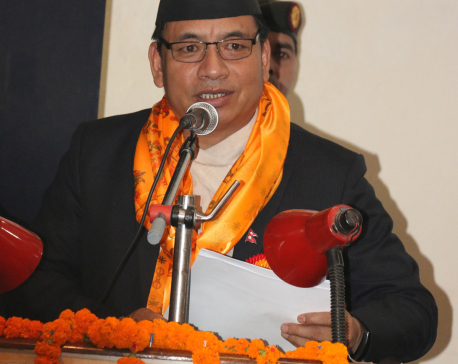
OR


Simone Galimberti
Simone Galimberti is the Co-Founder of ENGAGE, an NGO partnering with youths to promote social inclusion in Nepal.simone_engage@yahoo.com
Big employment generating programs must be carefully evaluated while small innovative pilots should be supported.
According to the Asia and The Pacific SDG Progress Report 2021, recently released by UNESCAP, we should all feel a great deal of urgency in achieving the Sustainable Development Goals or SDGs.
Despite some positive progress, the entire region is far behind in ensuring a sustainable, durable and resilient recovery that might project this vast continent to new levels of equitable prosperity and wellbeing.
As things stand today “on its current trajectory, the region may achieve less than 10 percent of the SDG targets” says the report and so far “the region is progressing towards no poverty (Goal 1), zero hunger (Goal 2), quality education (Goal 4), reduced inequalities (Goal 10) and partnership for the goals (Goal 17), but progress is not sufficient”.
The case of Nepal, too, is worrisome: there has been tremendous improvement if we think about reduction in child mortality and increasing educational enrollment at basic school level and yet the people, especially the most marginalized citizens, suffer.
A strong national public health system that also integrates private hospitals does not exist and the people are often being forced to fork out huge amounts of money to provide for their health care.
Similarly community schools, despite the investments, lag behind their private counterparts and as a consequence, there are huge learning inequities across the country, further marking a divide between the young citizens left behind and their peers who can access quality but expensive education.
On the positive side, one thing that has been promoted by the federal governments in the last few years - something often criticized by economists as unsustainable - has been social protection policies, handing out money to those in most need.
As challenging as it is in terms of fiscal sustainability of a country, social protection measures are the most effective way, in the short term, to deal with high pockets of vulnerabilities and we know how deep - even before the pandemic - these areas have been existing across the country.
External development partners should therefore work with the federal government to come up with new innovative social protection measures that will, albeit temporarily, help the most disadvantaged members of society to not remain further behind.
At the same time, it is essential to come up with innovative strategies and programs focused on youths’ holistic development.
A major report jointly published last year by the ADB and ILO, “Tackling the COVID-19 youth employment crisis in Asia and the Pacific” highlights how “prioritizing youth employment and maximizing youth productivity in the COVID-19 recovery process will improve Asia and the Pacific’s future prospects for inclusive and sustainable growth, demographic transition and social stability”.
“When young people feel empowered to earn a living through fulfilling work, and their energy, creativity and talents are nurtured, they can take up their roles as active, engaged citizens, contributing to a positive cycle of economic growth, investment and social justice” shares the report.
Employment of youths is going to be essential and the National Planning Commission in Nepal together with its counterpart and the recently established Policy Research Institute, have to be really creative in this strategic endeavor.
The report comes up with several recommendations like provision of wage subsidies, expansion of information and employment services and support for apprenticeship programs and increase in funds for demand-driven skills development, including funding for digital inclusion and support for young entrepreneurs.
The federal government and the provincial governments have been engaged in a series of undertakings in the area of youth employment but there is a huge room for improvement - both in the targets, approach and final outcomes.
It is essential to review the existing programs, improving or discontinuing them wherever necessary, while also supporting new innovative pilots, testing them and tailor-making them according to the needs arising.
To start with, what are the lessons learned with the massive Prime Minister Employment Program (PMEP)?
Which municipalities have been better able to use this program that allows the beneficiaries to get a job for minimum for at least 100 days?
How effective have they been while rolling out the program locally? Was it really of value for money?
Are there other promising programs being run locally?
Perhaps there are promising ideas being piloted locally by elected officials and such ideas could be better supported so that they can be scaled up at a later stage.
What about having stronger collaborations and partnerships with civil society organizations, social enterprises and private consultancies to harness their ingenuity for pilot programs that can enhance market-based skills of youth and provide them innovative apprenticeship and internships?
Maybe agencies like the UNDP and bilateral aid programs from the UK Government - the latter very focused on employment creation - could invest resources in trying out innovative ideas with the understanding that the federal and provincial governments will match the resources needed if the pilot programs are successful.
Interestingly, recently the USAID called for an expression of interest focused on employability of youth with disabilities and this should be the way to go and similar initiatives should be taken forward, even if at a smaller scale so that can be more easily taken advantage of by a wider number of stakeholders.
Ensuring a stronger ownership by the associations representing the interests of the private sector like FNCCI and the Nepal Chamber of Commerce is key.
After all, who better than them can help bring on board business executives in designing and implementing innovative on-the-job schemes?
Offering employment schemes to the most vulnerable youth should be a matter of pride rather than just a public policy imperative.
Recently, Prime Minister KP Oli shared he hopes Nepal will be able to achieve the SDGs by 2030.
This should be the top priority for any politician in the country and investing energies in designing innovative youth-focused development programs is a matter of urgency especially if youth who are vulnerable and marginalized are given a shot.
Galimberti is the Co-Founder of ENGAGE, an NGO partnering with youths to promote social inclusion in Nepal. He can be reached at simone_engage@yahoo.com
You May Like This

Tap youth potentials for domestic development
In the past 10 months of the current fiscal year (FY 2022/23), Nepal has witnessed a concerning trend: over 660,000... Read More...

Rely on youth
Enabled by youth, local forums can help generate a new sense of civic engagement focused on achieving the Agenda 2030. Read More...

Youth involvement essential for agriculture development: VP Pun
KATHMANDU, July 4: Vice President Nanda Bahadur Pun has stressed on modernization, professionalization and mechanization for sustainable agricultural development. ... Read More...





Just In
- NRB introduces cautiously flexible measures to address ongoing slowdown in various economic sectors
- Forced Covid-19 cremations: is it too late for redemption?
- NRB to provide collateral-free loans to foreign employment seekers
- NEB to publish Grade 12 results next week
- Body handover begins; Relatives remain dissatisfied with insurance, compensation amount
- NC defers its plan to join Koshi govt
- NRB to review microfinance loan interest rate
- 134 dead in floods and landslides since onset of monsoon this year












Leave A Comment